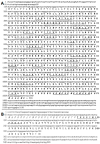Developmental Expression of HSP60 and HSP10 in the Coilia nasus Testis during Upstream Spawning Migration
- PMID: 28754007
- PMCID: PMC5541322
- DOI: 10.3390/genes8070189
Developmental Expression of HSP60 and HSP10 in the Coilia nasus Testis during Upstream Spawning Migration
Abstract
Heat shock protein 60 (HSP60) and heat shock protein 10 (HSP10) are important chaperones, which have been proven to have essential roles in mediating the correct folding of nuclear encoded proteins imported to mitochondria. Mitochondria are known as the power house of the cell, with which it produces energy and respires aerobically. In this regard, the obtained HSP60 and HSP10 have typical characteristics of the HSP60/10 family signature. Their mRNA transcripts detected were highest during the developmental phase (in April), while the lowest levels were found in the resting phase (after spawning in late July). Additionally, the strongest immunolabeling positive signals were found in the primary spermatocyte, with lower positive staining in secondary sperm cells, and a weak or absent level in the mature sperm. At the electron microscopic level, immunogold particles were localized in the mitochondrial matrix. Data indicated that HSP10 and HSP60 were inducible and functional in the Coilia nasus testis development and migration process, suggesting their essential roles in this process. The results also indicated that HSP60 may be one indicator of properly working mitochondrial import and refolding in the fish testis. This study also provides an expanded perspective on the role of heat shock protein families in spawning migration biology.
Keywords: Coilia nasus; Heat shock protein 10; Heat shock protein 60; Spawning Migration.
Conflict of interest statement
The authors declare no conflict of interest.
Figures







Similar articles
-
Molecular Characteristic, Protein Distribution and Potential Regulation of HSP90AA1 in the Anadromous Fish Coilia nasus.Genes (Basel). 2016 Jan 28;7(2):8. doi: 10.3390/genes7020008. Genes (Basel). 2016. PMID: 26828521 Free PMC article.
-
FoxL2 combined with Cyp19a1a regulate the spawning upstream migration in Coilia nasus.Gene. 2019 Aug 20;710:307-315. doi: 10.1016/j.gene.2019.05.037. Epub 2019 May 22. Gene. 2019. PMID: 31125733
-
Developmental expression of heat shock protein 60 (HSP60) in the rat testis and ovary.Differentiation. 1996 Jun;60(3):159-67. doi: 10.1046/j.1432-0436.1996.6030159.x. Differentiation. 1996. PMID: 8766595
-
Disease-Associated Mutations in the HSPD1 Gene Encoding the Large Subunit of the Mitochondrial HSP60/HSP10 Chaperonin Complex.Front Mol Biosci. 2016 Aug 31;3:49. doi: 10.3389/fmolb.2016.00049. eCollection 2016. Front Mol Biosci. 2016. PMID: 27630992 Free PMC article. Review.
-
Toward Developing Chemical Modulators of Hsp60 as Potential Therapeutics.Front Mol Biosci. 2018 Apr 20;5:35. doi: 10.3389/fmolb.2018.00035. eCollection 2018. Front Mol Biosci. 2018. PMID: 29732373 Free PMC article. Review.
Cited by
-
Schistosoma sex-biased microRNAs regulate ovarian development and egg production by targeting Wnt signaling pathway.Commun Biol. 2024 Dec 31;7(1):1717. doi: 10.1038/s42003-024-07402-z. Commun Biol. 2024. PMID: 39741204 Free PMC article.
References
-
- Charles S., Bravo De La Parra R., Mallet J.P., Persat H., Auger P. Annual spawning migrations in modelling brown trout population dynamics inside an arborescent river network. Ecol. Model. 2000;133:15–31. doi: 10.1016/S0304-3800(00)00277-5. - DOI
-
- Jiang T., Yang J., Liu H., Shen X.-Q. Life history of Coilia nasus from the Yellow Sea inferred from otolith Sr: Ca ratios. Environ. Biol. Fishes. 2012;95:503–508. doi: 10.1007/s10641-012-0066-6. - DOI
-
- Liu K., Duan J.-R., Xu D.-P., Zhang M.-Y., Fang D.-A., Shi W.-G. Present situation of Coilia nasus population features and yield in Yangtze river estuary waters in fishing season. Shengtaixue Zazhi. 2012;31:3138–3143.
LinkOut - more resources
Full Text Sources
Other Literature Sources
Research Materials
Miscellaneous

